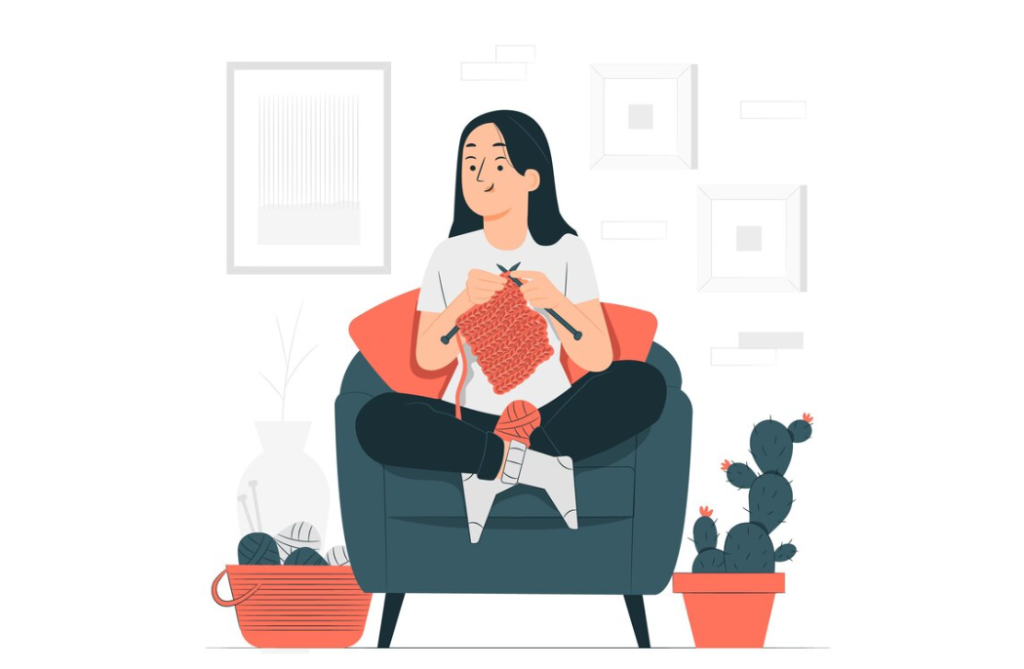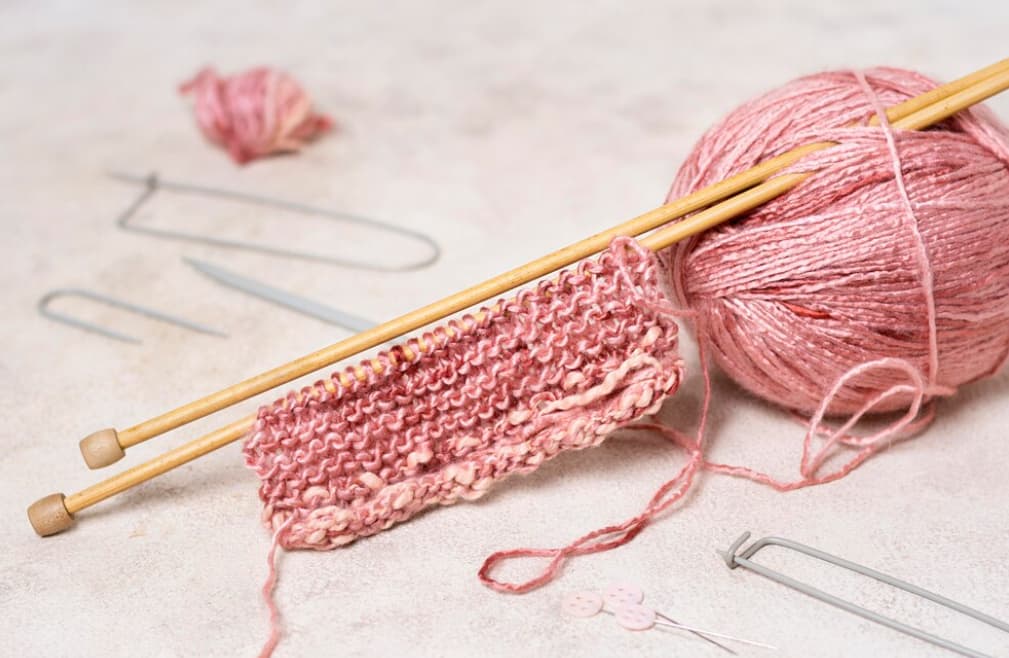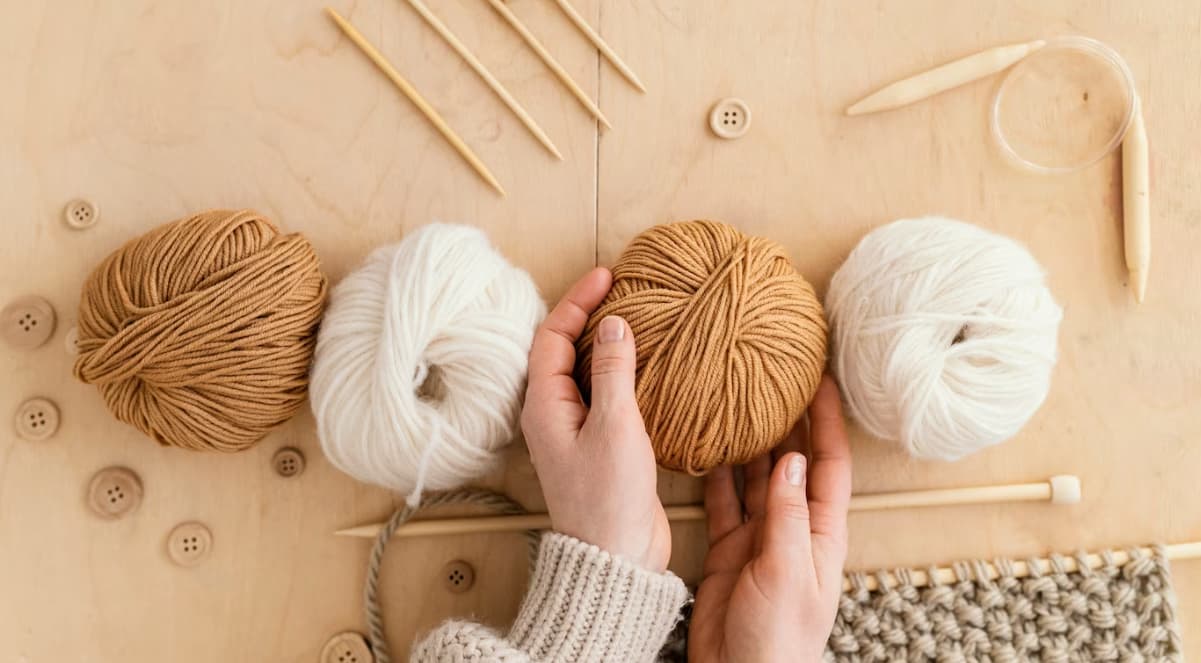Preventing Knitting From Curling
This guide covers various strategies for preserving the shape of stockinette stitches and preventing them from curling at the edges. When working on knitting projects like scarves or intricate designs, you might encounter the issue of the fabric losing its intended form after a few rows. This guide aims to provide solutions to help you prevent this undesirable curling effect.
This tutorial is the perfect destination. Presented here are seven techniques designed to maintain flat edges in knitting. It might seem troublesome, yet the solution is straightforward. Addressing common knitting challenges, it’s also crucial to understand how to fix a dropped stitch in knitting, ensuring that your work remains neat and consistent.
First, however, it’s critical to comprehend why this issue occurs.
Why Does Knitting Curl?
The Stockinette stitch, a common knitting pattern, is notorious for its tendency to curl at the edges. This issue stems from the natural imbalance between the knit stitches on the fabric’s face and the reverse side. In most knitting patterns, this isn’t an issue as they blend both knit and purl stitches.
In contrast, the Stockinette stitch is composed exclusively of knit stitches on the front, causing the fabric to curl towards the knit side at the base and the purl side along the sides. Some suggest this curling is due to varying stitch sizes, but it mainly occurs due to the dynamics of tension.
An effective way to understand this is by examining a Stockinette stitch sample. You’ll observe that it folds more readily vertically on the knit side and horizontally on the purl side. This curling corresponds to the natural tension lines: horizontal on the knit side and vertical on the purl side.
The “V” shaped stitches form vertical columns, while the purl bumps extend horizontally towards the edges. The fabric naturally contracts along these paths to reduce tension, much like how a rubber band forms a loop.
This comparison is especially apt, considering that many animal fibers are highly elastic. Knitting stretches these fibers, and they later shrink back to their original state. This characteristic renders materials like wool more susceptible to curling.
Grasping this fundamental concept makes it easier to devise effective countermeasures. Now, let’s explore the methods to effectively tackle and resolve this curling challenge.
Strategies to Minimize Curling in Your Projects
Explore seven pivotal methods to reduce curling in your knitting projects. Rather than applying them separately, think about merging them to achieve the best outcome.
It’s crucial to understand that not every technique is applicable to finished projects. If you’ve stumbled upon this guide post-completion, you’ll find that methods 3 to 7 are more likely to effectively tackle any persisting curling issues.
Implementing Selvage Stitches
Curling in fabric is a consequence of tension and innate structural weaknesses. A proactive strategy to combat this is to introduce a unique border that alters these fabric traits. In knitting terminology, this is known as a border or edge stitch, which is essentially a “self-edged” finish, featuring two or three stitches that differ from the main pattern sequence.
There are primarily two kinds of borders that effectively neutralize curling: Borders that interrupt folding lines by mixing knit and purl stitches, and those that reduce tension through the inclusion of slipped stitches or eyelets. Here, we explore some of the top techniques, though there’s ample scope for inventive variations.
#1 Garter Stitch Edge
In the stockinette stitch, you knit all stitches on the front side and purl on the back side. For a ribbed edge, you adjust the pattern as follows:
- Front side: Knit every stitch;
- Back side: Knit the first two stitches, purl until you reach the last two stitches before the edge, then knit these final two stitches.
This border design is straightforward and can be adjusted to 3 or 4 stitches based on your project’s scale. For a practical example, look at a basic washcloth pattern that includes this type of edge.

#2 Seed Stitch Border
A seed stitch border, akin to a garter stitch edge, typically involves a 3 or 4 stitch-wide edge. The pattern repeat is adjusted as follows:
- Right side: Purl 1, knit 1, purl 1, knit the remainder, purl 1, knit 1, purl 1;
- Wrong side: Purl 1, knit 1, purl 1, purl the remainder, purl 1, knit 1, purl 1.
For a broader edge, simply continue alternating between knits and purls.
#3 Slipped Stitch Border
A slip-stitch border offers a more subtle edge, though it is slightly more complex and requires careful row tracking (a row counter is advisable).
| Row Type | Instructions |
|---|---|
| Right Side | Knit 1 stitch, slip 1 stitch purlwise with yarn in front, knit 1, knit until three stitches remain, knit 1, slip 1 stitch purlwise with yarn in front, knit 1 stitch |
| Wrong Side | Slip 1 stitch purlwise with yarn in front, knit 1 stitch, slip 1 stitch purlwise with yarn in front, purl until three stitches remain, slip 1 stitch purlwise with yarn in front, knit 1 stitch, slip 1 stitch purlwise with yarn in front |
This selvage is slightly thicker but offers reinforced edges.
#4 Lace Border
Lace knitting, which combines decreases and increases to create eyelets for decorative, airy fabric, can also be applied as a border.
The pattern for a lace edge is:
- Right side: Knit 1, Yarn over, Knit two together, knit until three stitches remain, knit two together, yarn over, knit 1;
- Wrong side: Purl across.
This approach is more intricate, requiring more than just knit and purl stitches, but is an excellent opportunity to learn new techniques.
Implementing a Hem in Knitting
To eliminate the issue of curling at the bottom edge of a knitted hat, an effective solution is to incorporate several rows in an alternate stitch pattern, such as a 1×1 rib or a twisted rib.
When selecting a rib stitch for a flexible hem, it is essential to use needles that are one size smaller than those employed for the main fabric. This approach guarantees the creation of a well-defined hem that does not excessively stretch (typically, a 1×1 rib exhibits 5-10% more stretch compared to stockinette stitch).
The pattern for a rib stitch hem is as follows:
- Row 1: Knit 1, purl 1;
- Row 2: Purl 1, knit 1.
These two rows should be repeated 4 to 6 times, depending on the desired hem width, before transitioning to stockinette stitch. For circular knitting, simply repeat row 1 continuously, ensuring an even number of stitches are cast on.
Alternatively, a simpler method involves adding three or four rows of garter stitch at the bottom:
Row 1-6: Knit all stitches
Then proceed with stockinette stitch.
The transition between rib stitch and stockinette stitch tends to be smoother, but this is subject to personal preference.
An alternative method for preventing edges from curling in stockinette stitch is to start simply and, after the first three rows, pick up stitches from the reverse side and merge them with the stitches in the current row.
The initial casting technique is also key. Using the conventional longtail cast-on offers you the option to start with a knit or purl row. This method naturally leads to knit stitches in the first row. If you choose to begin with knitting, this creates a subtle ribbed border, which is effective in lessening the curling effect.
In contrast, beginning your project with a purl row leads to immediate pattern knitting. This approach gives a cleaner edge but might contribute to increased curling.
#2 Exploring Alternative Stitches
The stockinette stitch, commonly used for scarves and hats, is known for its simplicity. However, alternatives like the rib or garter stitches not only provide an attractive finish but also extra warmth. These variations don’t suffer from the typical curling seen in stockinette stitch, thanks to their blend of different stitch types. They are also reversible, looking the same on both sides. A notable variant is the double stockinette stitch, which resembles the regular stockinette but without the tendency to curl.
The method to knit it involves:
- Knitting each row by alternating between Knit 1, slip 1 purlwise with yarn in front;
- It’s important to note that the double stockinette stitch is more yarn-intensive and produces a narrower output for the same number of stitches, as essentially each row is knitted twice.
Another highly recommended stitch for scarves is the Brioche Stitch, known for its voluminous and soft texture. Additionally, a guide on calculating yarn requirements for scarves may be useful for efficient planning.
#3 Blocking Knitting
Much like how hair becomes more manageable when wet, yarn, often made from animal hair, behaves similarly. After completing a knitting project like a scarf, soaking it in lukewarm water with mild soap for about 30 minutes makes it more pliable. This should be done gently, without vigorous stirring. After soaking, the project needs to be carefully wrung out, laid on an old towel over a soft surface, shaped with pins, and left to dry.
This technique, known as blocking, is commonly used by knitters to shape and even out the stitches of a project. Once dry, the project retains its shape until it becomes wet again. While blocking can reduce curling in stockinette stitch, it won’t completely eliminate it, and the fabric may gradually return to its original state.
Blocking is most effective on organic fibers. For acrylic yarns, heat treatment, like using a steam iron, is necessary, but caution is advised to avoid melting the fabric.
#4 Incorporating a Crochet Border
While using a border stitch at the beginning of a knitting project is helpful, it may not fully solve curling at the bottom or sides of a completed scarf. A viable approach to address this is by adding a crochet border. This method involves using a crochet hook to work into the furthest knit stitch along the edge and creating one or two rows of double crochet chains on each side. This technique not only changes the look and feel of the final product by merging knitting and crochet but also allows for the introduction of a contrasting color, adding a creative twist to the design.
For those who are less proficient in crochet, there’s an alternative technique that involves picking up stitches along the edge with a knitting needle to form a side border, possibly using a seed stitch. Implementing three to four rows of this stitch, followed by a relaxed bind-off, can efficiently prevent the edges from curling.
An important factor to consider is the ratio of knit to crochet stitches. Since a knit stitch is broader than its height, it’s recommended to skip every second or third stitch when using the needle or crochet hook, to avoid creating a border that’s too tight.
#5 Adding a Fabric Lining

For those adept at sewing, adding a lining to the back of a scarf can be a practical choice. It’s important to choose a fabric that matches the weight of the yarn. Before sewing, blocking the scarf is recommended. This technique is quite popular; for instance, many fur scarves and stoles feature a silk lining. To keep the stitches hidden on the front side of the scarf, hand sewing with a fine needle is the best approach.
#6 Using Larger Knitting Needles
Using bigger knitting needles is a simple yet effective method to decrease curling. Larger needles create a looser gauge, giving each stitch more space and thus diminishing the curling effect. Some light blocking might still be needed to smooth out any minor waves along the edges, but overall, this method significantly reduces curling. It’s worth noting, though, that this change can affect other aspects of the knitwear, possibly making it more flowing but less warm.
#7 Technique For Dropping Stitches
For those open to experimentation, particularly in fixing a curled scarf, the technique of dropping stitches offers an interesting approach. This involves letting go of the second-to-last stitch on each side and unraveling that column down to the bottom. There are two ways to proceed:
- Accept the resulting appearance, block the piece, and wear it proudly;
- Use a crochet hook to reattach purl stitches up to the top, preferably from the back side, forming a chain stitch with each loop.
#Bonus: Incorporating Wire and Glue
An unorthodox but effective method for stiffening knitwear, especially in home décor, is the incorporation of wire along the edges. The wire provides structure, allowing the knit item to hold unique forms. Alternatively, using a light glue or starch to shape the knitting as it dries can be effective. This technique might alter the texture of the knitting but has been creatively used in projects like knitted containers.
Understanding The Role Of Curled Edges In Knitting Projects
Curling edges in knitting are often seen as a challenge, but there are circumstances where they are either inconsequential or even desirable. In projects like flat-knitted sweaters, the concern about curling diminishes significantly. Once the individual pieces, such as the back and front, are sewn together, the curling issue typically resolves itself.
A key aspect of understanding curled edges lies in recognizing the inherent characteristics of certain stitches, like the stockinette. Historically, it was predominantly used in tubular projects such as stockings, where the natural curling contributes to the desired round shape of the garment.
Innovative knitting techniques can also embrace and utilize curling to an advantage. For instance, knitting in the round offers unique solutions. By strategically placing a purl stitch at specific points in the round, it’s possible to create intentional fold lines in tubular scarves, thus managing the curling while adding a design element.
Similarly, in hat knitting, the natural curling at the bottom can actually form a desirable hem, adding to the aesthetic and functional aspects of the hat. This demonstrates the importance of creative thinking in knitting, where understanding the natural behavior of stitches can lead to intentional and beneficial design features.
Conclusion
While curling in knitting can often be seen as a problem, understanding its root cause and employing suitable techniques can turn this bug into a feature. Techniques such as adding selvage stitches, using different stitches, applying blocking, or adding crochet borders can dramatically reduce or eliminate curling. Additionally, unconventional methods like knitting with larger needles or dropping stitches can also fight against curling. However, it’s crucial to remember that in certain scenarios, curling might also be beneficial — contributing to the shape or style of the project. With knowledge and creativity, any knitter can turn the tendency of knitting to curl into an advantage.
